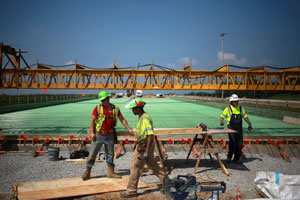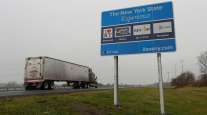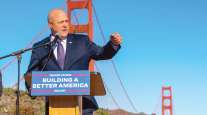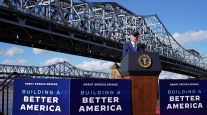Crumbling Infrastructure Fix Seen With Global Trillions of Dollars

The concrete piers of two new bridges are rising out of the Ohio River between Louisville, Kentucky, and southern Indiana, as crews blast limestone and move earth to build the roads and tunnels that will soon connect the twin spans to nearby interstate highways.
For more than two decades, the project languished. Business and political leaders on both sides of the river couldn’t agree on how to relieve snarled traffic, improve safety and spur development that was bypassing the region for Indianapolis and Nashville.
The Ohio River Bridges project is an American anomaly that has the potential to become a model while lack of money and political will are allowing many of the nation’s roads and bridges to crumble. Along the shores of the Ohio, Democrat-led Kentucky and Republican-run Indiana have forged a partnership to rebuild U.S. infrastructure at a time of partisan gridlock and untapped trillions in private dollars.
“It’s an enduring irony that the U.S., allegedly the home of innovation, is absolutely block-headed and backwards in this one respect,” former Indiana Governor Mitch Daniels, now the president of Purdue University in West Lafayette, Indiana, said in an interview. “America needs the upgrade and modernization of our infrastructure, and I don’t think you’ll get there if you keep excluding, or at least discouraging, private capital.”
President Barack Obama’s administration, which had resisted private financing of public works, is starting a new center to serve as a one-stop shop for bringing capital into government projects. During a Sept. 9 infrastructure conference with investors, U.S. Treasury Secretary Jacob J. Lew said while direct federal spending is indispensable in such cases, tight budgets demand creative ways for unlocking private money.
His cabinet colleague, Transportation Secretary Anthony Foxx, put it more bluntly when he announced the Build America Investment Initiative in July.
“There will always be a substantial role for public investment,” Foxx said. “But the reality is we have trillions of dollars internationally on the sidelines that are not being put to work.”
Fixing those roads and bridges also boosts employment. Every $1 billion in new infrastructure investment creates about 18,000 jobs, according to a 2009 report by economists at the University of Massachusetts’ Political Economy Research Institute.
An Indiana economic-impact study estimated that the Ohio River Bridges project alone will generate an average of 15,500 jobs annually through 2042. Planners promise a safety dividend as well: The river’s juncture is a national crossroads of truck traffic that has seen higher accident and injury rates than U.S. averages, according to a crash study.
For Indiana’s share of the $2.3 billion project, the state is using WVB East End Partners to finance, design, build and maintain for 35 years a new bridge and highway approaches. The group consists of Walsh Investors LLC of Chicago; Vinci Concessions SAS, based in Rueil-Malmaison, France; and Bilfinger Project Investments North America, a division of the German builder Bilfinger SE.
While Kentucky lacks the legal authority for such a deal and is using more traditional public financing for its portion, Democratic Governor Steve Beshear is pushing for legislation to allow Kentucky to use public-private partnerships for transportation work. The old model of relying on federal funding is no longer viable, he said.
“The practical facts are that if we are going to have any large infrastructure projects in the foreseeable future, it’s going to have to involve the private sector,” Beshear said. “That’s where the money is, and that’s where people are willing to put money up in order to get these projects built.”
Institutional investors such as Montreal-based Caisse de Depot et Placement du Quebec have capital and want to invest in U.S. infrastructure because it meets their long-term objectives, said Macky Tall, Caisse’s vice president of private equity and infrastructure. The Caisse is Canada’s second-biggest pension-fund manager, with C$214.7 billion ($190.7 billion) in net assets as of June 30.
There hasn’t been more investment because the U.S. is behind other countries in tapping private capital, Tall said, and there’s been a lack of expertise, legal authority or receptivity to it in some parts of the country.
“We as the investors keep it very simple: We only go and invest where that capital is desired and considered helpful,” he said. “We really only make these investments where there is appetite for that capital.”
Tall said U.S. states are becoming more comfortable with private investment, in part because there are more examples of successful projects and fewer alternatives to pay for mounting infrastructure needs.
The U.S. has used mostly fuel taxes and public financing for such projects. And the federal gasoline tax hasn’t been raised since President Bill Clinton was in office. A divided Congress only managed a short-term measure in July to prevent the Highway Trust Fund from becoming insolvent.
California passed the first legislation allowing public-private partnerships for transportation projects in 1989. Today, 33 states and Puerto Rico have such authority, according to the National Conference of State Legislatures.
After years of debating the Ohio River bridges, Daniels and Beshear got on the phone late in 2011 and agreed to split the work, paying for each share separately.
Kentucky’s portion includes a new six-lane downtown bridge for northbound Interstate 65 from Louisville and a reconfigured “Spaghetti Junction” where I-65 and two other interstates meet. Indiana is building a new bridge eight miles (13 kilometers) upstream connecting Louisville’s east end with southern Indiana while also expanding highways and building twin tunnels under historically protected property to connect to the new span.
Indiana’s history of tapping private industry for transportation work includes the $3.8 billion, 75-year lease of the Indiana Toll Road that Daniels sought in 2006 to pay for roads and bridges. The toll road’s private operator sought bankruptcy protection last month when traffic didn’t match projections.
The state’s piece of the Ohio River Bridges uses a different public-private financing model that could require taxpayers to cover any shortfall in tolls. The Indiana Finance Authority issued $677 million in tax-exempt, private-activity bonds in March 2013 on behalf of WVB East End Partners. The authority is also making $392 million in “milestone” payments during construction and annual “availability” payments for 35 years — assuming the operator maintains the bridge — using toll revenue on the new spans that the states are splitting.
The toll-road bankruptcy may prompt some government planners to question using availability payments and require private operators to assume more risk, said Robert Poole, director of transportation studies at the Los Angeles-based Reason Foundation, which advocates free markets. It still makes sense for governments to take on some risk in return for private investment, as long as they account for the liability, Poole said.
The agency has done just that, said Stephanie McFarland, spokeswoman for the Indiana Finance Authority. While the toll-road deal involved “aggressive traffic projections” and financing, she said, the Ohio River Bridges project is based on conservative traffic estimates and low-interest debt.
Indiana’s approach won “project of the year” recognition last year from groups including the Washington-based American Road & Transportation Builders Association, which called it “a prime example of the ingenuity” of public-private partnerships. The tools had been used before, though rarely on a project of such scale involving two state governments, the association said.
Kentucky is using more traditional financing that includes bonds backed by toll revenue, a low-interest federal loan and Grant Anticipation Revenue Vehicles bonds, or Garvees.
The failure to craft more innovative approaches has left an unmet U.S. infrastructure need that the American Society of Civil Engineers estimates will reach $3.6 trillion by the end of the decade. The list of stalled projects includes a replacement for the Interstate 5 bridge connecting Portland, Oregon, and Vancouver, Washington, and a new Brent Spence Bridge between northern Kentucky and Cincinnati, Ohio.
Officials in those bordering states have been unable to agree on the scope or funding as Kentucky and Indiana have with the Ohio River Bridges. Beshear said he’d like private financing as an option for the Brent Spence Bridge, just as public-private partnerships have been used for the Denver FasTracks rail project and the replacement of the Goethals Bridge between New York City and New Jersey.
Institutional investors say they would like to invest more in public infrastructure — if only there were more suitable projects willing to take their money. If there were, it would mean an additional $2.5 trillion in investment globally through 2030, according to a 2013 study by the McKinsey Global Institute. The U.S. has the potential to be the largest public-private partnership market in the world because of the size of its infrastructure and urban populations, Moody’s Investors Service said in a Sept. 8 report.
The swift financial closing of the Ohio River Bridges project — fewer than nine months — suggests the U.S. is ready for more public-private partnerships, said Xavier Huillard, Vinci’s chief executive officer.
“American lawyers are now good at dealing with such contracts, credit-rating agencies that rate bond issues, they’re all ready to deal with the concept of PPPs,” Huillard said in an Aug. 1 earnings call. “And that’s probably the sign that PPPs should start to take off in the United States.”
One remaining barrier to private investment is that projects generally require a dedicated funding stream such as tolls, which some Americans oppose on top of paying taxes, said Robert Palter, director of McKinsey’s infrastructure practice in Toronto.
While residents in Louisville and southern Indiana aren’t happy about tolls for the new Ohio River bridges, the work has been needed for decades, said Rebecca Bethard, who bought a house with her husband that overlooks the bridge work in Indiana. It will cut her 40-minute commute to Louisville in half, and the value of their home should only increase, she said.
“Tolls are a fair trade-off for getting it done,” Bethard, an attorney, said in an interview. “The benefits outweigh the costs.”
The unreliability of conducting business in the region was significant, said Kerry Stemler, chairman of the Louisville area’s chamber of commerce, who helped lead a bi-state bridges authority. U.S. military convoys have even diverted around Louisville because of the congestion, he said.
“Not to move forward with this project basically was saying to this city and this part of the country that we’re not going to be participating in the future growth of the country, and that’s not acceptable,” Louisville Mayor Greg Fischer said in an interview.
Companies in the region support the project, including United Parcel Service Inc., which operates what it calls the world’s largest fully automated package-handling facility at Louisville International Airport, and Ford Motor Co., which employs about 8,800 at its Louisville Assembly Plant and nearby Kentucky Truck Plant.
The bridge project may generate an average of 15,556 jobs a year from 2012 to 2042 in the region, with $29.5 billion in personal income and $86.7 billion in economic output, according to a March update of a study prepared by the Economic Development Research Group Inc. in Boston.
The promise of better interstate access and flow of commerce is already attracting companies including Amazon.com Inc. to the 6,000-acre River Ridge Commerce Center, the former Indiana Army Ammunition Plant near where the east end bridge is being built, said Jerry Acy, the center’s executive director.
The juxtaposition of work being done by the two states using different financing models also will provide a unique opportunity for comparison over time, said Daniels, the former Indiana governor. He called it “about as close to a political trial as you’re ever likely to have.”
Investors are watching, said Raymond Levitt, director of the Global Projects Center at Stanford University.
“If this Ohio River project finishes up really well, that’s going to be, I think, a beacon for foreign investors to say, ‘This can be done in the U.S.,’” Levitt said.




